 What is Macrostock? Micro stock and Macro stock
What is Macrostock? Micro stock and Macro stock
What is macrostock? In the industry of selling licenses for the use of pictures in advertising, magazines etc., known as “stock photography,” there are generally two major traditions:
- What is macrostock? Traditional pricing, also called high pricing, traditional marketing or “macrostock” describes an old industry that until recently has had a monopoly on the market for over 50 years. In the old days, licenses for pictures were sold and marketed through catalogs and sent to customers by mail. Individual pictures were often licensed for amounts anywhere from $500 USD to $10,000 USD, depending on usage. In those days it was extremely hard to be accepted as a photographer at the different stock agencies and to start selling stock—some photographers would work for years to build a portfolio to show the agencies.
- Micro payment selling, also called “microstock” describes a new and highly competitive form of selling stock. Here, pricing depends on the resolution of the picture you buy. This allows for a “micro” or minimal price for ultra-low resolution images. When it was first introduced, this upset a lot of traditional stock photographers – including me. Taking full advantage of the internet for distribution of the images (instead of catalogs) and inviting everyone with a digital camera to submit pictures (provided their pictures were good enough), in many ways, microstock became the direct opposite of macrostock.
The early years in microstock. When did microstock start?
When microstock started back in 2004, the price difference between a RF full-res bought via macrostock and RF full-res bought via microstock was about twenty to one and often more. Today the difference is about ten to one and sometimes five to one. Over the years it is expected that the two pricing traditions will merge and only a small margin will remain between micro and macro prices.
I sell my pictures within both industries, but primarily focus on microstock for the time being. I do this based on a set of considerations and ideas about the future development of the industry.
The best microstock agencies are:
Istock, Fotolia, Shutterstock, StockXpert, Dreamstime, 123RF, Bigstockphoto, Crestock
The critical aspects posted here has been moved to this this post about problems with microstock
——————————————————————————————————————–
These are just a few of the challenges in this new industry. However, there are also many upsides to microstock. If you are about to enter microstock as a photographer, you can read my “Two minute quick guide to microstock,” which will mention most of the things you need to know about where to sign up, what agencies to submit to, income level etc.



















